KING COAL: Bowing To The King No More
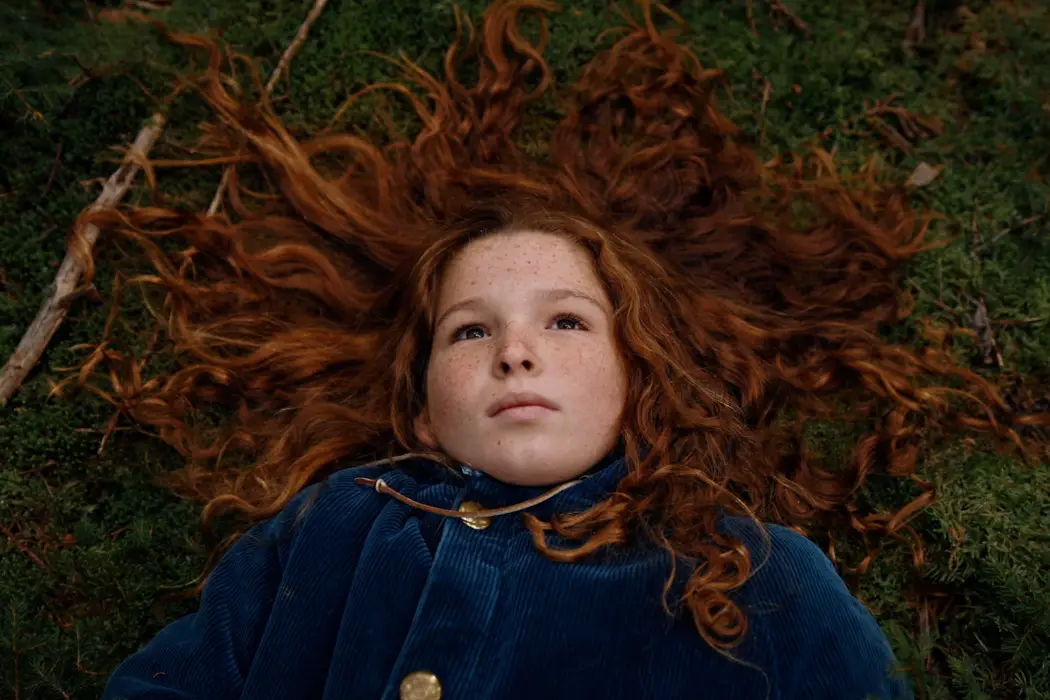
Brian Walter is a college professor by day and a…
God save the king!
According to the King James version of the Bible, this exhortation was first shouted by the Israelites when the prophet Samuel informed them that God had granted their wishes and selected Saul to be their first king. It didn’t matter that God had just upbraided the people for insisting they wanted someone to rule over them – needless when the Lord their God had delivered them through the clutches of so many enemies into the Promised Land. No, the installation of a very human potentate, one whose personal jealousies would eventually produce serious trouble, was automatic cause for celebration.
Now, in a lovely, lyrical, and carefully unsettling poem of a movie, celebrated filmmaker Elaine McMillion Sheldon has once again questioned the wisdom of contriving an absolute authority figure to bow down to. In the Appalachians where she hails from, coal reigned as king for much of the 20th century, but not anymore, and her artfully ambivalent film sets the still weighty pull of coal’s kingly past against the region’s hopes for a freer, more sustainable future.
Breaking with the Past
The film divides itself into roughly two narrative strands. One focuses on King Coal’s continued sway over the people of Appalachia, a mountainous region crisscrossed by the borders of several states, including not just West Virginia, but also Kentucky, Pennsylvania, Ohio, Virginia, and more. Coal’s pervasive power in the region has been celebrated by everyone from country singer Loretta Lynn to documentary filmmaker Barbara Kopple.
The second narrative strand focuses on a pair of West Virginia schoolgirls who attend events, make school projects, and while away the time, talking and dancing. In the ideas and dreams they share, the girls embody the hope of a future beyond the king’s reign.
To emphasize King Coal’s lingering power in the region, director Sheldon features many scenes of community gatherings. The film opens with the dropping of a huge block of coal in one town’s New Year’s Eve celebration, features clips of a footrace where organizers throw coal dust on passing runners, and places the camera strategically to emphasize the appreciative but meager crowd at a coal-shoveling contest. One of the most memorable of these scenes features a high school football game in which the home team, the Miners, each touch a rough-hewn piece of coal mounted on a pedestal as they emerge from the locker room to run out on the field.
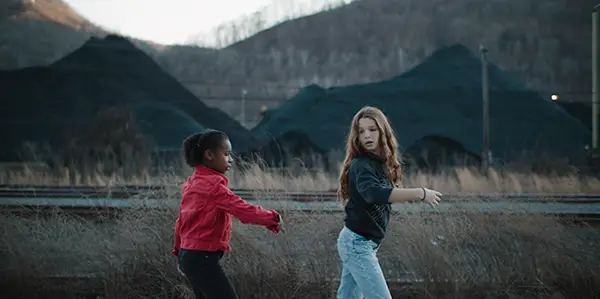
Sheldon initially sets the camera low and on the opposite side of the rough-hewn ebony touchstone, cutting the players’ faces out of the top part of the frame so that only their uniforms and their hands appear on screen. The power of coal erases the individual identities of the players, anonymous young paladins taking the gridiron in service to the king.
The two schoolgirls who form the focus of the other narrative strand are never named in the film, but they write their signatures on it indelibly. Always in motion, often dancing, intently observing the proceedings of official events, they engage curiously and respectfully with the geological liegelord, but they are never bound to him.
While it would be easy to romanticize the girls, making them into latter-day counterparts of William Blake’s sad chimney sweeper in Songs of Experience, perhaps, Sheldon manages to blend them naturally into the film’s visual and narrative schemes while simultaneously according them full personhood. They are both the subjects of the camera’s eye and the free subjects of their own imaginations.
Through them, director Sheldon answers a question asked in the voiceover narration: what are we without coal? They respect the power of the past and the king’s rule over it, but they are intuitively independent and preparing themselves for a future without it.
Indoctrination vs. Education
In an early scene, a former coal miner got up in helmet, suspenders, and coal-blackened work shirt holds a class of schoolkids spellbound with his stories of working in the mines. At the end, the kids flock to the guest to touch the piece of coal he has brought with him, one exclaiming that it feels like a diamond.
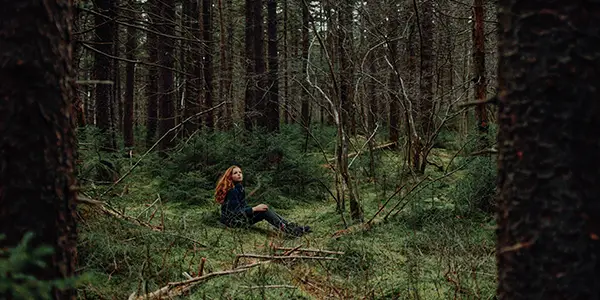
In a different film, this could feel like a scene of indoctrination, showing how the youngsters are being drafted as early as possible into preserving the king into the next generation. But in King Coal, the scene feels more like a warning: the king still has some faithful apologists who are inflicting propaganda on the most innocent of masses.
More appealing are the many quieter scenes of less formal education. One of my favorites shows the taller, red-haired girl visiting a family farm and listening as the mother explains the healing properties of the plants they live among. Soon, the mother calls to the family flock of sheep, who hesitate but then come running down a grassy hillside to her.
It’s a simple visual answer to the crucial question, what are the residents of Appalachia without King Coal? People surrounded by extraordinary natural wealth and vitality, not bound to the profiteering that the king used to make possible.
The King’s Funeral
The film opens with a beautiful long shot of a funeral procession moving slowly along a green hillside with the mountains and sky rising into the distance behind them. It’s a perfect prelude for the memorial service that Sheldon ends the film with.
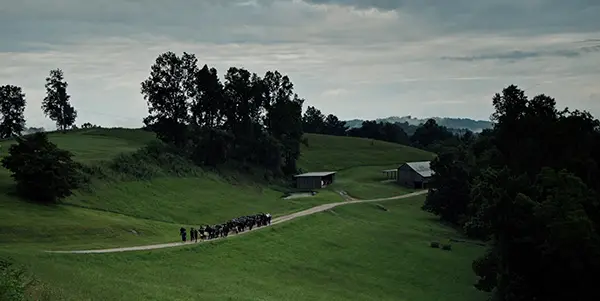
Bidding farewell to the king is a matter both of ritual and of craftsmanship, including shots of the casket being made by hand, the logs cut and planed by a skilled woodworker.
At the memorial service, a soloist accompanied only by a drum calls out the farewell verses and is answered by the chorus, “Beneath the linden tree.” It’s a traditional musical farewell for the end of a contrived tradition that was never meant to last, but only to reap mammon from a region that – as this film shows – once was and now must become again so much more.
The bookended funeral scene conjures (among other allusions) “God’s Funeral,” Thomas Hardy’s bracing poem about the death of the divine. But unlike Hardy’s mourners, who give voice to an era’s loss of faith in the heavenly king of English Christianity, the death march in King Coal is as freeing and hopeful as it is mournful.
Coal Country, U. S. A.
As reviews have noted, King Coal is intensely and self-consciously elegiac. But make no mistake: it’s also restless and corrective, unwilling to bow the knee anymore to a monarch who needs to die and take his court with him.
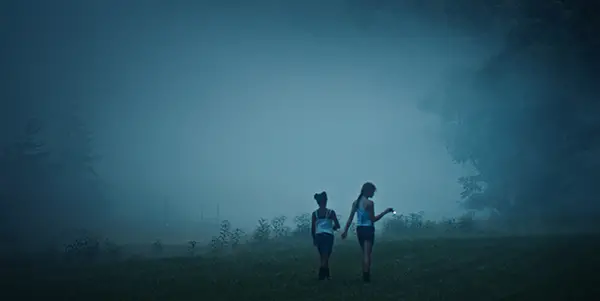
The clear antecedent for this film is Barbara Kopple’s terrific 1976 documentary, Harlan County, U. S. A., which chronicles the horrors and the delimited but heroic triumphs of an Appalachian coal miners’ strike against corporate exploitation. Kopple’s film doesn’t exactly celebrate the dirty, dangerous work of coal mining, but it certainly celebrates the miners and their dedication to their labor.
Made almost half-a-century later, Sheldon’s film walks a fine line between respecting the people who still pay obeisance to the king and arguing forcefully that their allegiance is misplaced and long overdue to end. With the lovingly orchestrated funeral service, King Coal offers itself as the means to an honorable final passage for the king.
Artful Agenda
The term “documentary” has always been easy to misunderstand, suggesting that the camera works as a mere observer, simply documenting what people do. But that’s never been the case, going all the way back to Robert Flaherty’s proactive direction in Nanook of the North (1922), in which he asked Nanook to stage a variety of actions specifically to be filmed.
A century later, Sheldon makes no bones about staging various actions for her film. In that sense, it’s much less a mere ‘document’ than an artistic essay, a deeply personal attempt to explore a sensitive, complicated topic and share the fresh, urgent truths yielded by the effort.
When we see the red-haired girl near the end of the film dancing in a pavilion or running free along a raised sidewalk, we know that we’re not just witnessing the death of a king, but the birth of a vision for the future.
It would be possible to criticize King Coal for being almost too personal, too idiosyncratic, perhaps even too convinced of the righteousness of its own polemic. Some residents of Appalachia are still doing just fine with the king and, no doubt, don’t want anyone telling them it’s time to bury him with his crown. But Sheldon takes care to frame her argument not as a mere case of needful progress. She gives the king a proper send-off, a loving, peaceful, honorable goodbye.
King Coal is a rare work of art that manages to look forward precisely by looking backward, putting boundaries around the past only to make it part of the future. God is done saving the king, and the Appalachians and America will, the film poignantly suggests, be all the healthier for it.
Does content like this matter to you?
Become a Member and support film journalism. Unlock access to all of Film Inquiry`s great articles. Join a community of like-minded readers who are passionate about cinema - get access to our private members Network, give back to independent filmmakers, and more.
Brian Walter is a college professor by day and a hopelessly sleepy college professor by night. His work has appeared in a variety of literary and film studies publications, and he appears as an 'old coot' interviewer with a magic camera in the final chapter of Donald Harington's final novel, "Enduring." He lives a short walk from the St. Louis Zoo with his remarkably patient, loving wife and a quirky assortment of canine and feline familiars.













